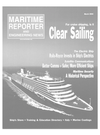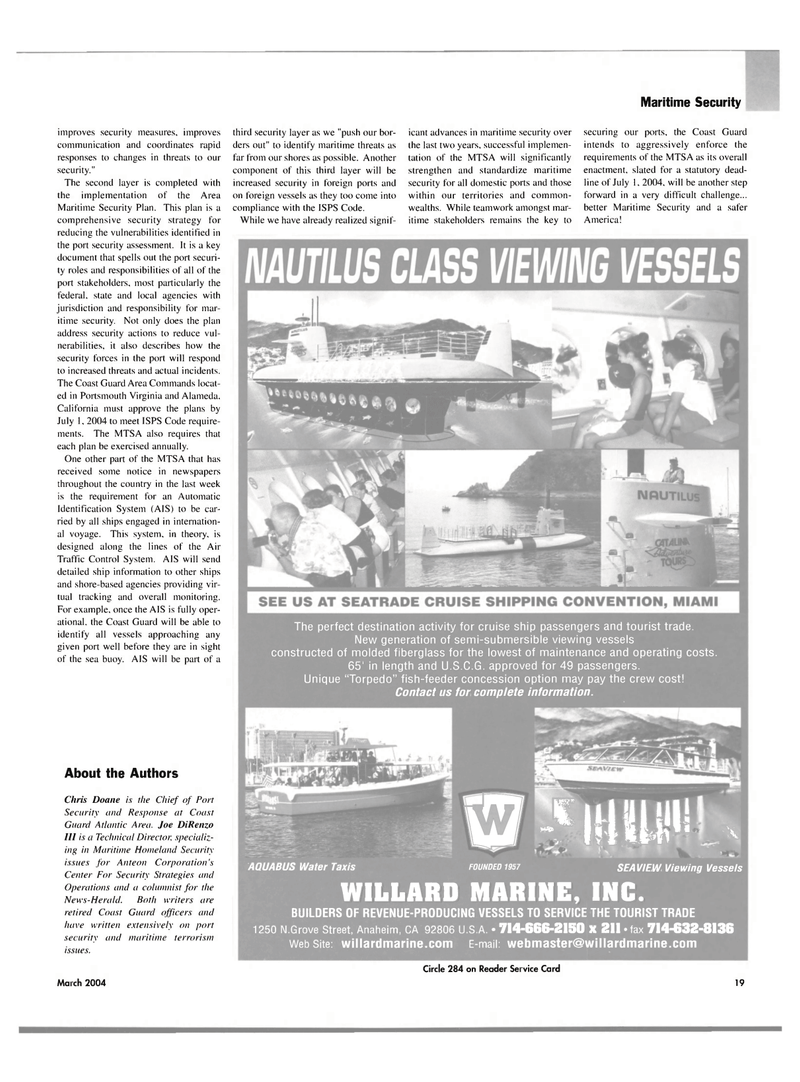
Page 19: of Maritime Reporter Magazine (March 2004)
The Cruise Shipping Edition
Read this page in Pdf, Flash or Html5 edition of March 2004 Maritime Reporter Magazine
Maritime Security improves security measures, improves communication and coordinates rapid responses to changes in threats to our security."
The second layer is completed with the implementation of the Area
Maritime Security Plan. This plan is a comprehensive security strategy for reducing the vulnerabilities identified in the port security assessment. It is a key document that spells out the port securi- ty roles and responsibilities of all of the port stakeholders, most particularly the federal, state and local agencies with jurisdiction and responsibility for mar- itime security. Not only does the plan address security actions to reduce vul- nerabilities, it also describes how the security forces in the port will respond to increased threats and actual incidents.
The Coast Guard Area Commands locat- ed in Portsmouth Virginia and Alameda.
California must approve the plans by
July 1, 2004 to meet ISPS Code require- ments. The MTSA also requires that each plan be exercised annually.
One other part of the MTSA that has received some notice in newspapers throughout the country in the last week is the requirement for an Automatic
Identification System (AIS) to be car- ried by all ships engaged in internation- al voyage. This system, in theory, is designed along the lines of the Air
Traffic Control System. AIS will send detailed ship information to other ships and shore-based agencies providing vir- tual tracking and overall monitoring.
For example, once the AIS is fully oper- ational. the Coast Guard will be able to identify all vessels approaching any given port well before they are in sight of the sea buoy. AIS will be part of a
About the Authors
Chris Doane is the Chief of Port
Security and Response at Coast
Guard Atlantic Area. Joe DiRenzo
III is a Technical Director, specializ- ing in Maritime Homeland Security issues for Anteon Corporation's
Center For Security Strategies and
Operations and a columnist for the
News-Herald. Both writers are retired Coast Guard officers and have written extensively on port security and maritime terrorism issues. third security layer as we "push our bor- ders out" to identify maritime threats as far from our shores as possible. Another component of this third layer will be increased security in foreign ports and on foreign vessels as they too come into compliance with the ISPS Code.
While we have already realized signif- icant advances in maritime security over the last two years, successful implemen- tation of the MTSA will significantly strengthen and standardize maritime security for all domestic ports and those within our territories and common- wealths. While teamwork amongst mar- itime stakeholders remains the key to securing our ports, the Coast Guard intends to aggressively enforce the requirements of the MTSA as its overall enactment, slated for a statutory dead- line of July 1, 2004. will be another step forward in a very difficult challenge... better Maritime Security and a safer
America!
The perfect destination activity for cruise ship passengers and tourist trade.
New generation of semi-submersible viewing vessels constructed of molded fiberglass for the lowest of maintenance and operating costs. 65' in length and U.S.C.G. approved for 49 passengers.
Unique "Torpedo" fish-feeder concession option may pay the crew cost!
Contact us for complete information. x3- mm'" ' Tk-%
AOUABUS Water Taxis FOUNDED 1957 SEAVIEW Viewing Vessels
WILLARD MARINE, INC.
BUILDERS OF REVENUE-PRODUCING VESSELS TO SERVICE THE TOURIST TRADE 1250 N.Grove Street, Anaheim, CA 92806 U.S.A. • 714-666-2150 X 211 - fax 714-632-8136
Web Site: willardmarine.com E-mail: [email protected]
Circle 284 on Reader Service Card
March 2004 19

 18
18

 20
20
